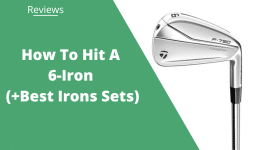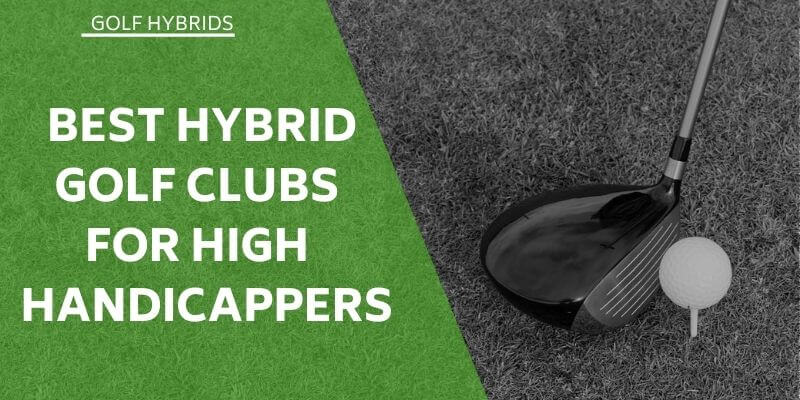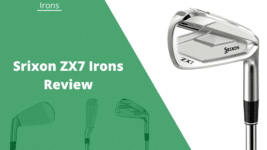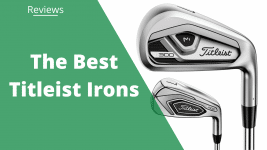In our Titleist AP3 review, we will look at how the manufacturer has designed players distance irons to go long and be forgiving.
Things To Consider Before Buying a Set of Irons
If you are a lower handicap golfer, this is definitely not the first time that you have been in the market for a set of irons. Here are a few pointers to refresh your memory, before you go out splurging on a new set.
Ball Speed
The speed that your ball leaves the clubface, will determine how long it is in the air, and ultimately how far it will go. If you have a faster swing speed you likely have no problem generating enough ball speed with any club. However, if your swing is on the slow side, you will need to consider irons that can help you increase your ball speed upon impact.
Golf coaches estimate that for an extra mile per hour of ball speed, you end up with two additional yards of carry. Generating ball speed is a combination of four factors, physical power, mobility, technical, and equipment. Each factor contributes 25% to you achieving faster ball speeds.
If you are a low handicap but struggle with generating ball speed, it may be worthwhile looking at game improving irons that can help you improve your launch and distance.
Workability
Mid to lower handicap golfers enjoy the ability to shape their shots and have more control over the trajectory of their ball. If you are one of these golfers then you want to consider irons that are not offset, and move in the air on your backswing enabling easier manipulation of the club on your follow-through.
Again, blades tick all the boxes here, however, if you want some forgiveness in your club then a players iron or players distance iron may be better suited to your needs. Having a forgiven club without compromising on the ability to shape your shots is hard to not consider.
Clubhead Design
The standard options of clubheads are oversize, mid-size, and blades. Oversize clubheads are not the prettiest creations, but they are forgiving and help you achieve consistent distance and direction. These irons are generally offset, and have cavity backs, which create a larger sweet spot, by pushing the weight away from the clubface and distributing it evenly in the sole.
Irons with mid-size clubheads are designed to provide you with the forgiveness of cavity back irons, and the distance of blades. Semi cavity backs as they are known, are best suited to the mid handicap player, looking to maintain distance even on heel and toe mishits.
Blade irons should only be considered once you are completely confident in your ability to strike every ball consistently in the same spot. The feeling and sound you get when you hit a crisp blade shot are incomparable to any other clubhead, however, when you get it wrong, it can be catastrophic.
These are unforgiving clubs with a small sweet spot. The weight is concentrated behind the area of the sweet spot, allowing you to maneuver the club in the air, and manipulate a draw or a fade.
Course Design
The abundance of golf products on the market, often leads us to focus on the ability of the clubs, and not the environment in which we play. Think about the course you play most often, before purchasing a new set of irons.
If the course plays long, you are going to want any extra help you can get with distance. However, if the fairways are narrow, then accuracy is key, and you may want to think about offset clubs that help you hit the ball squarer.
Besides distance and accuracy in the fairways, you should factor in the layout of the greens. Are they tight or are they wide? If the greens are tight then you may want to consider a club that increases the spin on your ball, allowing it to land soft and stop rapidly.
If the greens at your home course wider, you may want to consider clubs that enable you to keep the ball lower and let it run up to the hole.
Wind
Obviously, we want it to be a perfect sunny day every time we play a round, but that is not always the case, and we should not allow the weather to ruin our game. The biggest challenge that the average golfer has when it comes to weather, is wind.
If the wind at your home course often picks up without warning, you are going to want to look at irons that help you keep your shots lower. Ask your golf fitter or sales representative for irons that have strengthened loft. This means that they are lower in loft and help you keep the ball down in the wind. These types of clubs are also ideal if you play on a links-style course.
Titleist 718 AP3 irons were created by combining the power and forgiveness of the manufacturer’s AP1 with the workability of the AP2 range. The idea was to create a set of irons that were forgiving but offered the distance and feel of a players iron.
AP3 irons are Titleist’s attempt to create a range that catered to a broader segment of the market. Often forgiving irons are not the most attractive clubs, and lower handicap players prefer the look and feel of blades. The AP3’s were designed to look like a players iron, whilst including all the technology that is found in game improvement irons.
The performance of the AP3’s has been impressive, and even tour professionals Byeong Hun-n, Bill Haas and Jimmy Walker carry them in their bags. If you are a 12 handicap and below and have challenges with generating sufficient ball speed then these irons match what you need.
Features & Benefits
1. Less Offset
The reduced offset in the AP3’s allows you to manipulate the clubhead easier on your backswing, which will allow you to have more control of the shape of your shot. This is more appealing to the mid to low handicap player who wants the ability to induce a draw or fade depending on the lie of the ball.
2. Hollow Body Construction
Hollow body irons are built for distance, and are commonly fitted on players irons. The unsupported face typically leaves you a smaller sweet spot, but helps you increase your ball speed.
Titleist fitted tungsten alloy into the soles of their irons to give you more weight on the heel and toe. This minimizes the difference in the distance on mishits, in comparison to shots struck out of the middle.
3. L-Face Inserts
Titleist’s L-face inserts create a face that is fast, thin, and unsupported. This design helps to improve your ball speed, which gives results in you hitting higher, longer shots that land softly to high levels of spin.
4. Tungsten Alloy
Tungsten is one of the most durable materials and can withstand significant impact before reaching breaking point. Titleist inserted 84.9 grams of tungsten into the soles of the AP3 long and mid irons, to help you generate faster ball speeds across the clubface. This results in the characteristics of game improvement irons being fitted into a club that is shaped and finished like a player’s iron.
5. Ascending Mass Shaft Technology
Traditionally golfers have found irons that carry the same shaft weight from long irons all the way down. This has prevented you from maximizing your performance with each iron. The AP3’s were designed using ascending mass shaft technology.
The weight of each shaft is increased by 3 grams as you move down from a 4 iron to your wedges. This enables you to get distance and power on longer iron strikes, and height and spin on your shorter approach shots.
Titleist AP3 Iron Alternatives
1. Taylormade P790’s
These are player’s irons created to give you maximum distance. The hollow back clubhead is paired with a super-thin clubface, which sandwiches a polyurethane-foam filling, that Taylormade calls “SpeedFoam.SpeedFoam increases your ball speed off the clubface at impact, giving you more distance, while the weight on the back of your club provides you with a bigger sweet spot. Resulting in better forgiveness. The soft absorbing foam reduces vibrations upon impact, leaving you with a smooth feeling club.
Even though the P790’s are forgiving clubs, they don’t have the bulk appearance of offset game improvement irons. They are slick-looking blades that fold around the sole and give you a satisfying sound and feel at impact. You will only know what I am referring to if you have played with blades in the past.
Taylormade P790’s appeal to the mid to lower handicap golfer, looking for forgiveness on the odd occasion. Furthermore, slower swinging golfers will benefit from the added assistance with ball speed.
2. Callaway Mavrik Pro Irons
Callaway has gone all out when it comes to employing technology in the design of their Mavrik Pro irons. Each iron was crafted using artificial intelligence, resulting in a clubface uniquely tailored to loft, ball speed and spin, depending on the club.
Like the Titleist AP3 irons, the Mavrik Pro’s were designed using tungsten weights. This enabled Callaway to better identify the center of gravity with precision, allowing for a more powerful launch and higher ball flight.
The irons contain urethane microspheres between the clubface and the back of the clubhead, designed to eliminate vibrations in the club at impact. The smooth feel allows you to maximize the Coefficient of Restitution (COR), which is the energy retained when your clubface smashes the ball. The better your COR the faster your ball speed is likely to be.
As is the case with the other alternative irons to the Titleist AP3’s, the Mavrik Pro’s are better suited to lower handicap golfers. This is because you will not receive the same level of forgiveness as game improving irons, and need to be confident in your game to take this range on.
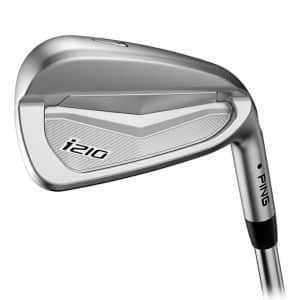
A softer elastomer material that is 50% softer than other polymers is inserted into the clubface of the i210’s to give players a smoother feeling when striking the ball. The softer elastomer increases face contact by 25%, transferring more energy onto the ball at impact which generates quicker ball speed.
The sole of the irons was amplified to boost the glide of the clubs through the rough and in wet conditions. Ping finished the clubs in HydroPearl Chrome 2.0, which removes water from the path of the club, allowing you to achieve better contact with your ball.
More compressed grooves with a sharper edge were applied to the design of the i210 irons, offering you enhanced precision. The technology helps reduce the risk of hitting it in the teeth when you need the ball to land soft and next to the target.
The Ping i210 irons are better suited to lower handicap golfers from 8 downwards, looking for a modern set of players irons. It is advisable to visit a fitter if you are interested in these clubs, as they offer a wide variety of shaft flex, weight and launch angle.
Final Thoughts
Titleist have tried to broaden their target market with the AP3 irons, appealing to mid to lower handicap players. These clubs combine the best features of the AP1 irons which was their power and forgiveness, with the AP2’s workability and easy on the eye appearance.
From my side, I would recommend these clubs if your swing speed is on the slower side. The technology inserted in the AP3 irons will boost your ball speed and help you consistently with distance.
Single-digit handicap players that struggle to achieve consistency with length should benefit significantly from the AP3’s. These irons will help to put you in contention for more birdies on par 5’s and longer par 4’s.
If you feel that these clubs tick all the boxes, in terms of those best suited to your game, you can look at the Titleist AP 3 irons here.
Related Articles
- Titleist 917 D2 Review; A Driver To Consider
- Titleist AVX Golf Ball Review; How Do These Balls Stack Up?
- The 5 Best Driving Iron; Generate The Longest Distance
Nick is the founder of GolfSpan and an avid golfer. He's not quite a pro but has over 15 years of experience playing and coaching golfers worldwide. His mission is to bring the golfing community a better experience when it comes to choosing the right golf gear and finding the right setup for your game.

